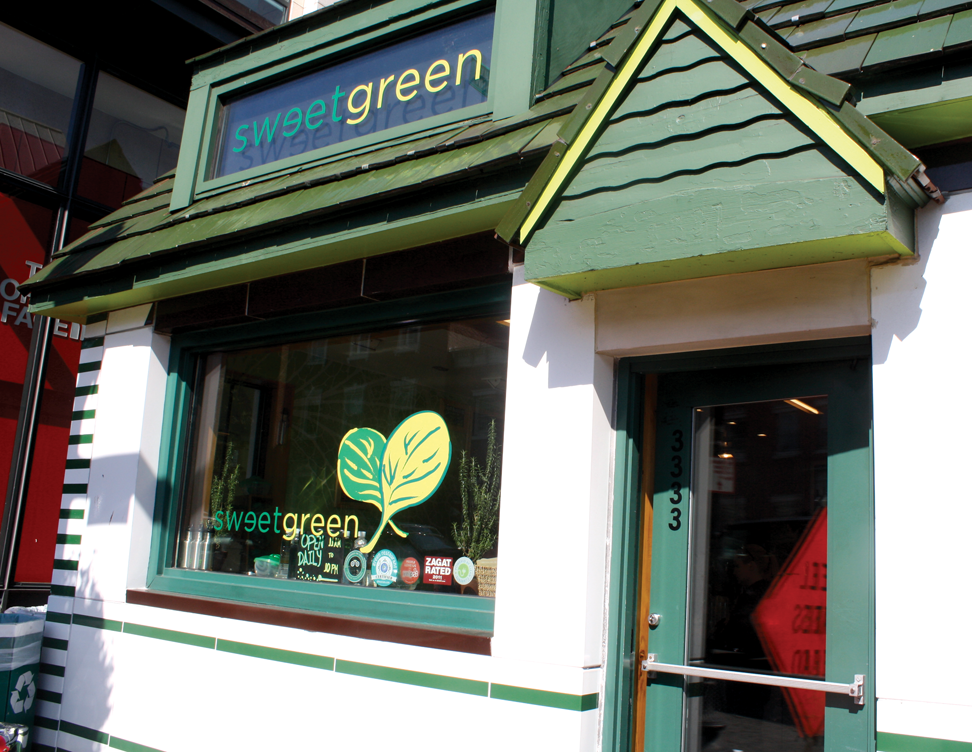
With consistent year-to-year profits, Sweetgreen has bucked a trend of declining sales seen by local shops.
As more national retail brands move into the neighborhood, local small businesses are feeling the pressure.
According to Jim Bracco, executive director of the Georgetown Business Improvement District, the area has seen a 10 percent increase in chain store openings in recent months; this brand of retailer now occupies 40 percent of area storefronts.
Local bars and eateries are also suffering from the economic pinch. Saloun, a popular M Street bar known for its live music, will close its doors on Oct. 19.
Saloun’s general manager, Yasmine Afshar, cited high rents and a changing neighborhood as reasons for the close.
“[The residents] want a high-class clientele, and they want quiet,” she said. “The dynamic of the neighborhood has completely shifted. It’s not about keeping ma and pop stores around.”
Afshar added that Saloun and other pubs have struggled in ways that retail shops have not.
“Chain retail stores don’t have as much trouble. They don’t have to worry about licensing or protesting from the residents. They have lawyers and financial backing, and they close at 9 p.m.,” she said.
According to Raji Rankins, manager of the M Street urban clothing and accessory store Da Closet, her shop will soon have to relocate to either the U Street area or Silver Spring, Md., because of consistently low profits.
“We’ve taken such a dramatic hit being down at Georgetown,” said Rankins, whose store currently operates out of the Shops at Georgetown Park mall complex on M Street. “Business is slow. There’s not a lot of traffic.”
“[Georgetown] is not a district set up for small businesses,” Rankins said, adding that he believes the neighborhood’s atmosphere, not the national recession, has hurt small businesses.
“None of [the local Georgetown businesses] are making money.”
But Bracco thinks that local businesses’ struggles reflect a wider trend.
“Retail is challenging right now, even for the chains. People aren’t spending,” he said, pointing to greater troubles within the national economy.
As shops struggle to deal with the local and national economic downturn, students are beginning to notice the atmosphere of decline.
“I think that the Georgetown mall is a sad place; it actually gives me an eerie feeling because it’s so empty,” Erika Charleston (COL ’12) said. “In this community we are sort of sheltered. The mall is a glimpse of what the economy is really like in the U.S.”
Adam Paegle (COL ’13), a native of the D.C. area, said that he thinks the community surrounding the university has lessened its support for small businesses.
“When I was in high school, Georgetown was the place to go. We all wanted to come down here — it was like Adams Morgan. But the residents don’t want the area to be a destination for tourists, they want it to be exclusive,” he said.
Charleston said that she thinks the neighborhood’s priorities have visibly shifted toward luxury boutiques.
“It seems to me that stores catering to a middle class clientele have lost their customers,” she said. “But the fact that Brooks Brothers opened … shows that some people are still willing to shell out for super-luxury goods,” she said.
Thomas Cooke, a distinguished teaching professor in the McDonough School fo Business, said that Georgetown has tailored its marketing efforts to the high-end shopper.
“It doesn’t surprise me that the small businesses are suffering,” he said. “The middle class shopper just isn’t coming to Georgetown. They know the discounts are few and far between.”
Wink, a small M Street clothing store that sells chic designer clothing, seems to have benefitted from this shift in demand.
“We don’t really feel the recession,” said Emily Rubin, Wink’s store manager. “We have our regulars who are still shopping, and we get tourists as well, thanks to our location.”
George Alabarenga, the store manager at Booeymonger’s Delicatessen located a few blocks away, said that sales have been slightly less predictable in 2011.
“Compared with other years, it’s kind of slow,” he said. “[It’s] up and down.”
But not all area restaurants have experienced this decline.
According to Sweetgreen manager Damaris Escobar, the M Street salad shop’s profits were about the same as they were this time last year. The company — founded in 2007 by Nicolas Jammet (MSB ’07), Jonathan Neman (MSB ’07) and Nathaniel Ru (MSB ’07) — has expanded to nine additional locations since its opening in 2007.
While there are no plans to move Sweetgreen to a larger facility, Escobar emphasized that the shop has no plans to downsize or leave the neighborhood.
Bracco mentioned that the historic nature of the neighborhood can make store expansion tough and rent prices high.
“We’ve got a lot of old buildings. It’s hard to make those spaces work sometimes,” Bracco said.
He added that he thinks members of the local business community, especially those specializing in clothing sales, can overcome the economic challenges that they currently face.
“We still had a large amount of small businesses opening up this year,” he said. “We are the leading neighborhood for fashion and shopping.”














